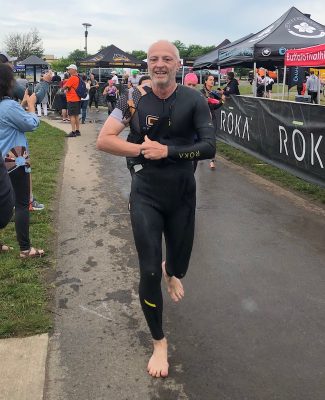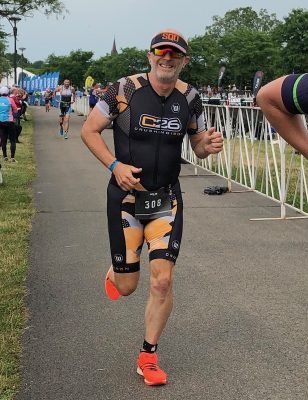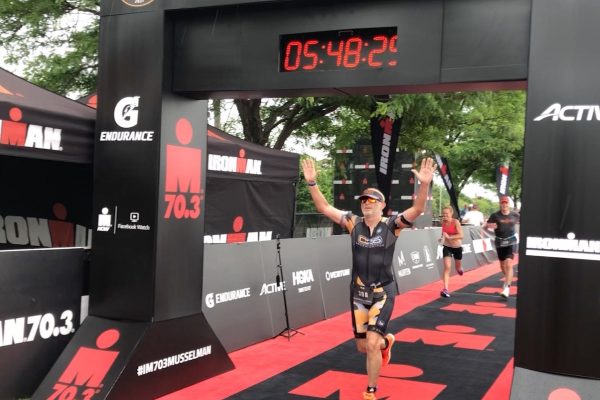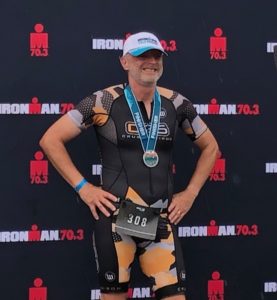
2021 Ironman 70.3 Musselman
I am publishing this race report to share details of the Ironman 70.3 Musselman race. Even though I had some challenges with my training going into the race, I was still able to produce a PR performance on the day. I hope you enjoy reading the report and equally, I hope that it helps you with your own triathlon journey.
Training Cycle
I had a challenging training cycle coming into this race. Sevens weeks earlier, I had participated at Ironman 70.3 Chattanooga, but did not finish due to some breathing issues. These breathing issues persisted for a few weeks, so I limited my pool swimming to avoid further irritation from the chlorine used at my pool.
By the beginning of July, my breathing problems were subsiding, but then I ran into another issue; a recurrence of the Achilles tendonitis that I had before my Chattanooga race. My coach and I discussed this and we decided to stop all running. I didn’t run at all for the ten days leading into the Musselman race.
In spite of the above challenges, I still felt reasonably fit as I entered race weekend. My bike workouts had been going really well, my breathing issue was under control and my Achilles was recovering well.
Race Logistics And Course Description
The 2021 version of Musselman was the first version under the Ironman brand. The race had existed as an independent half-distance triathlon since 2003, before being purchased by Ironman in 2019. The first Ironman 70.3 Musselman was supposed to occur in 2020, but the global Covid-19 pandemic caused it to be cancelled.
The Musselman course underwent some changes under Ironman. The swim start and finish location had changed but still involved a swim in Seneca lake. This year the swim started close to the swim exit point at the dock near the Finger Lakes Welcome Center in downtown Geneva. It was a very simple swim; straight out into the lake, turn right and swim for a couple of hundred yards before turning right again to head back to the shore. After exiting the swim up a ramp at the dock, there was a run of a few hundred yards past the Ironman village and finish line into transition, which was located on grass by the swim start.
The bike course was also changed by Ironman and avoided a short section of gravel riding that existed in previous versions of the race. I drove the bike course on the Friday before race day and was very glad I did this. The first section of the course took us from alongside Seneca Lake across to Cayuga Lake. The roads here were in good condition and the terrain was more rolling than I thought it would be. No steep slopes at all, but some longer shallow hills. At about mile 15, the course turned south on NY85. This road was perfect… fresh asphalt made it very smooth. It was also pretty much flat all the way to the next turn at Vineyard Road, about eight miles further south. After turning onto Vineyard Road, you hit an immediate and fairly steep hill and I was happy to be aware of this for race day; it allowed me to gear correctly for that turn.
The next nine miles of the bike course are all uphill. The total elevation gain is only about 750 feet, but it feels like a lot more because there is very little respite from the long slow climb to Ovid-Lodi Townline Road. The surface conditions on Ovid-Lodi Townline Road, were one of the main reasons for driving the course. I had seen some pictures on Facebook that showed lots of potholes and very poor road conditions in general. When I got there, I saw that the road was indeed in very bad shape. It was going to be possible to navigate this treacherous surface, but this was clearly going to require reduced speed. On my drive, I also noticed a very nasty bump in the road on the descent to CR131; again something to avoid on race day.
After turning north on CR131, the course continued its descent to the shore of Seneca Lake and then back to Geneva. Apart from a small uphill section at about mile 49, it was clear that this last third of the course was going to be very fast. I was excited to see if I had the legs to take advantage of this on race day.
The run course was originally designed as a single loop course with a fair bit of elevation gain. A few days before the race however, Ironman changed the course into a two loop course with much less elevation. This was apparently caused by not having enough volunteers to man all the aid stations. The new course avoided the notorious Barracks Road climb, so I wasn’t too disappointed about it. This was especially the case given my relative lack of run preparation. The new course involved an out and back along the lake shore, before passing the Ironman village and heading inland for a loop near Hobart and William Smith College. This inland section had some good elevation and also involved crossing a rail track (more of that later). This run course was very spectator-friendly, as it was possible to easily see runners at least four times during their half marathon.
In terms of logistics, the only real ‘challenge’ for this event is parking. Parking was at Seneca Lake State Park, a full one mile walk from transition. This made dropping off the bike on Saturday tedious and the mile walk back to your car after the race seemed to go on for ever. It must also have been frustrating for slower finishers on race day too. This was because the walk back to the parking area, was on the same path used for the run course.
Overall though, I think this course and event was run on a very fair course and the organization was first class. The volunteers were great and information on the event was very well communicated.
The Race
Race Morning
Race day morning proved very uneventful as I followed my well practiced routine. I woke up at 3.45am and made coffee to go with my standard race day breakfast of 2 cinnamon raisin bagels (nothing on them) and 2 small containers apple sauce. I applied my Trislide lubricant everywhere I was concerned about chaffing and put on my Wattie Ink C26 one piece triathlon kit. The temperature outside was quite warm, so I didn’t need to add any additional layers of clothing.
The previous evening, I had packed all the gear I needed for racing and had prepared my nutrition bottles. We grabbed all the gear and headed out the door. With the parking spot being about a mile from transition, we left the hotel a little earlier than normal. It was still dark.
Having left early, we didn’t have to wait long to get a parking spot. I grabbed all my gear and we started the long walk along the greenway by the lake to transition. The sun was beginning to rise and I could see that the lake was really calm. The swim course buoys were in place and I was feeling confident about my race. Setting up transition went smoothly and it was confirmed that the swim was going to be wetsuit legal.
Before long, we were lining up along the greenway for the swim start. I had found a number of C26 teammates and we chatted as we got into our wetsuits. I noticed that quite a few people were taking a warm up swim in the lake, so I decided to go do that. I only swam for a minute or two, but it was good to get a feel for the water and to let water into my wetsuit.
After listening to the national anthem, the countdown to the start began. The cannon went off and the first swimmers entered the water. By now, the wind had picked up and what had previously been a calm lake, was now quite choppy. The line to enter the water moved quickly, and before I knew it, I was at the front. It was time to start my race.
The Swim
We entered the water four swimmers at a time, leaving every five seconds. I was lined up on the left edge, which was furthest from the buoy line. I figured that because the course was a straight out and back, staying tight to the buoys was not critical except at the turns.
Swim starts are always a tough time for me. I can easily over exert myself and get into breathing difficulties. This, in turn, makes settling into a rhythm a problem. Today however, I did a very good job of staying under control and was into a nice rhythm before I got level with the first buoy.
By staying a little wide of the buoys, I was in clear water. There were very few swimmers ahead of me to worry about. With water being quite choppy, sighting was occasionally tough. I sometimes took two or three attempts to actually see the next buoy. It was also clear that we were swimming into a headwind. It seemed to take an age to get from buoy to buoy. Eventually however, the first red buoy appeared and I swam directly towards it. I wanted to make effective turns and not swim wide.
I encountered a lot of other swimmers when going around the buoy. There was a fair bit of contact but nothing aggressive or hard. At one point I took in a mouthful of water while breathing and choked a little. This was the only challenge I really faced on the swim. I took a couple of breast strokes, while I coughed and got back under control.
Once I had made the second turn and was heading back to shore, it felt like I was swimming really fast. Clearly the wind was helping me now. In the distance I could see the big white tents of the Ironman village, and knowing the swim exit was right there, I used these for sighting in the way back. I found myself swimming well coming back to shore and actually overtook quite a few other athletes. This gave me a real confidence boost and before I knew it I was at the swim exit.
Swim Time : 0:43:31

T1
Having exited the water, I ran up the boat ramp and along the path towards T1. This is where I saw my wife. She is always telling me I never see her, so I stopped, gave her a kiss and said “don’t tell me I didn’t see you this time!”.
Transition went quite well for me. I struggled more than I would have liked getting my wetsuit off. This was partly because I felt a minor cramp in my calf while trying to get out of it. I slowed down a little to take care of that cramp before it got bad. Once out of the wetsuit, things went smoothly and I ran with my bike to the mount line. Now came the critical part of my race.
T1 Time : 0:04:57
The Bike
Prior to the race, I had discussed tactics with my coach. Our normal approach to racing is to go hard on the bike leg, but not so hard that it compromises the run leg in any way. We normally chose to save the big push for the run leg. The run is where most time is usually gained (or lost). However, because I had not run for almost two weeks, and because we didn’t know how I would handle the run, we went with a different approach for this race. We decided I would go all in on the bike leg and try to hang on during the run. So, as I got onto my bike and started to ride, I thought to myself… ride like this is a short course race.
As a consequence of my race tactics, I soon started to pass a lot of other cyclists. I was careful to be very loud and deliberate with my voice, when passing. I wanted to make sure people knew I was there and was coming past. This actually helped a lot. Most people got further to the right side of the course and many actually thanked me for warning them. As I passed the five mile point, I took in some of my nutrition, put my head down and continued to push.
The road heading towards Cayuga Lake was a long slow gradual climb. It was a shallow enough climb however, that I was able to stay in the aero position all the way to the lake. I think the only time I came out of aero, was at the aid station, where I took on some water. As I turned south onto NY85, I was looking forward to enjoying the perfect road surface I had seen on my course preview drive. The road was indeed great to ride on, but unfortunately on race day, we were riding directly into a headwind. Nonetheless, I continued to ride well and felt like I was hitting my goals.
Then came the turn onto Vineyard Road and the nine miles of steady climbing. I went in and out of aero during the climb and focussed on taking in my nutrition. I finished my first bottle half way up the climb, which let me know my nutrition plan was on track. I successfully navigated the poor road surfaces along this section of the course and reached the top of the hills. It was now time to really fly.
I rode the second half of the bike course really well. I continued to push, but could feel my legs starting to get a little fatigued. This was not a surprise, given the effort I was putting out. I did start to worry about how my legs would feel on the run, but decided it was too late to change anything.
For me, the second half of the bike seems to take forever and then all of a sudden you are back at transition. It was the same during this race, even though in reality, I averaged a much faster pace coming home with the wind. My average speed for the last 25 miles was close to 25mph according to the Ironman tracker. Along the way, I had continued to pass a lot of people, including some friends who had exited the water before me.
The bike dismount line couldn’t come quick enough. My legs were so tired, I struggled to get off my bike. I survived however and ran into T2.
Bike Time : 2:33:27
T2
I thought I completed my transition quite well. After the race however, I noticed that my time in T2 was quite slow compared to the faster athletes in my age group. I guess that the fatigue in my legs from the bike, was impacting me more than I thought.
T2 Time : 0:03:53

The Run
As I ran out of the T2, I ate a gel and drank some water. I saw my wife and she said I was doing fantastic. She told me to absolutely go for it on the run. In spite of how my legs had felt on the bike, they didn’t feel that bad as I started along the greenway towards the State Park.
As always, my plan was to stay at a controlled pace for the first half of the run and then try to pick up the pace a little towards the end. The run along the greenway went well and the turnaround point appeared more quickly than I expected. This long, flat section of the course was a great help getting into a run rhythm and was not too taxing on my legs. All that was about to change however.
I ran back past the Ironman Village, saw my wife again and headed towards the hillier part of the run. As much as I was surprised how well my legs were holding up when running on the flat, I was shocked at how bad they felt going uphill. My quads were screaming at me and I naturally slowed down a lot as I ran up towards the loop near Hobart and William Smith college. The run around the loop wasn’t too bad and pretty soon, I was making the turn back towards the lake. That is when I got to experience something very new. I turned the corner onto Elizabeth Blackwell Street and saw it. A train was blocking the route!!
Fortunately, at the athlete briefing, the organizers had warned us of this possibility. At that briefing, they said that there were timing mats either side of the rail track, and that if we were stopped by a train, then they would be able to adjust people’s time. I was so glad that I had listened to this. It meant that I didn’t freak out when I saw the train and also allowed me to make sure I crossed the timing mat near the track.
While waiting for the train to pass, I slowly jogged around. I didn’t want to just stand there, as I feared starting up again would be too painful. Luckily, it was a short train and we were soon on our way again. I passed the village again, saw my wife again and started the second loop. I had decided that I would try to pick up the pace along the greenway. I didn’t think I would have it in me to do it on the hills. As I increased my effort, I actually felt quite good. Could I have a decent run after all?
A mile later, I knew the answer was ‘no’. My legs started to really hurt and I felt my pace gradually decreasing. It was now going to be a grind all the way to the finish. I still had about five miles to go. Those five miles were a real grind. I was really pleased with how I pushed through those miles. I did walk through a couple of the aid stations and for about fifty yards of the steepest hill, but that was all.
As with all Ironman races, as you approach the finish line, the sounds lift your spirits and you find a way to run just that little bit faster. For the last half mile I counted off the time, by repeatedly counting to ten in my head. Each time I got to ten, I knew I was closer to the pain ending. I rounded the final corner onto the red carpet and was really happy when I crossed the finish line. I collapsed into the arms of a volunteer almost immediately.
Run Time : 1:56:31
Overall Time : 5:22:19 (16th in age group)

Post-Race
I was able to pull myself together quite quickly, got finisher cap and medal, and found my wife. In spite of the far from ideal build up to the race, I had achieved a significant PR.
The post race food consisted of roast chicken and salted potatoes. It was fantastic and ate it all. I hung around for the next hour or so, talking to teammates and cheering on friends who were still out there running.
Having looked at the Ironman tracker, I saw that I had finished in 16th position in my age group. I realized that there was a very good chance that I could claim a roll down slot to the Ironman 70.3 World Championship. Before the race however, I had made the decision that I wanted to finish in the top ten, in order to take a World Championship slot. Based on this I decided not to attend the awards ceremony and my wife and I went back to our hotel. It turned out that I did indeed qualify via roll down, but I don’t regret not taking it. I didn’t feel my performance justified going to St. George.
Lessons Learned
Looking back on the race after a few weeks, it is clear to me that I learned quite a lot from this race. My approach to the race was very different from previous races and that is what taught me the most.
It is clear that even though I absolutely smashed myself on the bike leg in Musselman, I was still able to pull together a decent run. I can certainly run better than I did in this race, but my time was still one of my faster half marathon times in a 70.3 distance race. In future, I think I will be willing to push a lot harder during the bike leg; not quite as hard as I did here, but harder than I usually do.
I also learned that I need to push harder during the swim. This is especially the case, if I ever want to break into the top ten for my age group. I tend to swim very defensively. I swim not to ruin my race. I should be swimming with more confidence. The swim leg of my last three races has gone quite well, so I have no reason to fear failure any more.
Finally, I reinforced my belief that even though I am getting older, I can still get faster. This PR performance was still not quick enough to get me into the top ten in my age group, but next year I age up. If can get a little faster still, I will one day hit my goal.
